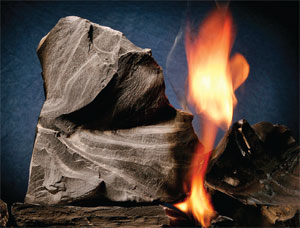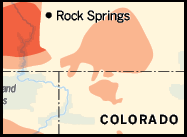CQ WEEKLY – IN FOCUS
July 21, 2012 – 10:00 a.m.
Cautious Progress on Shale’s Promise
By Lauren Gardner, CQ Staff
In the Green River basin of northern Colorado, Utah and Wyoming are sedimentary rock formations that potentially hold more than triple the oil reserves of Saudi Arabia, enough to make the United States energy independent.
The hitch is the rock.

|
||
|
Like the tar sands of Alberta, Canada, several hundred miles further north, the oil shale formations of the Green River basin must be coaxed into yielding their petroleum, a laborious, expensive and environmentally exhausting process of digging, heating, fracturing and refining. The end result is oil of somewhat lesser quality than the benchmark West Texas intermediate crude — something best used to make kerosene, jet fuel or diesel.
The oil industry had paid little attention to oil shale over the decades when crude was selling for less than $40 a barrel. It would cost much more than that just to get each barrel of oil from the shale, never mind any profit. The spike in oil prices that followed the Arab oil embargo in the 1970s and the Iranian revolution led to a burst of oil shale investment by government and industry, but the boom collapsed when oil prices fell back in 1982.
Today’s prices of around $100 a barrel, though, have made oil shale economically practical for the first time in three decades, encouraging those who see hope for increased development of domestic fossil fuels to meet rising demand.
But the prospect that the government might allow oil shale mining in Western states, including the public lands that make up most of the Green River basin, has revived concerns that extracting the oil would deplete scare Western water resources and lead to more pollution.
The Bureau of Land Management, which is reviewing its oil shale leasing program, will ultimately determine how quickly shale development proceeds and what extra steps should be taken to protect the environment — unless Congress steps in to speed up the leases.
“We need to move carefully to make sure we can produce oil from shale safely and responsibly, without depleting our limited water and power supplies or creating a destructive boom-bust cycle in Colorado communities,” says Colorado Sen.
Developing the Western oil shale reserves will require the kind of technology breakthroughs that fostered the boom in domestic gas and Canadian tar sands production. The shale contains a mix of organic chemicals known as kerogen, a solid or semi-solid form of petroleum that hasn’t been subjected to the enormous pressure and heat that would turn it into oil. At high temperatures, the kerogen releases petroleum-like liquids, which can then be refined.
Environmental Concerns
In addition to being costly — the Society of Petroleum Engineers estimated in 2009 that a barrel of oil from oil shale projects could cost from $38 to $62 — the process carries serious environmental challenges. Some extraction methods require huge volumes of water, while greenhouse gas emissions from the life cycle of the fuel would exceed those of conventional oil. Land disturbed by mining operations would also have to be reclaimed.
Cautious Progress on Shale’s Promise
Despite those challenges, major oil companies with research and development experience in the area may look to oil shale as a high-risk, high-reward solution to their future supply needs. “This is a small R&D expense for them,” Randy Udall says. “But underlying it is this question that everyone is asking: ‘Well, where is the world going to get its liquid fuels 20 years from now?’”
The first oil shale boom came to a halt when oil prices dropped in 1982, throwing thousands out of work and devastating western Colorado’s economy.
“I fully expect oil shale to be developed, ultimately,” says Jim Spehar, a former mayor in Grand Junction, Colo., and oil shale consultant, who says government should refrain from throwing money or cheap land at shale developers until viable technology emerges. “Now is an opportunity to take the time to do it right,” he adds.
Oil shale might not be cost competitive now, but James T. Bartis, a senior policy researcher at the Rand Corp., which has studied the issue, says the economics is guesswork until commercial operations develop.
“We really don’t know what it costs to get oil shale out of the ground,” he says, because no one has done it on a commercial basis.
Guy Caruso, head of the Energy Information Administration during George W. Bush’s presidency, says the key issue right now is the investment. “Will it be made on time and in the right places?” he asked at a recent industry-sponsored briefing.
Shifting Lease Policy
Renewed interest in oil shale among lawmakers was reflected in the 2005 Energy Policy Act, which directed the Bureau of Land Management to sell federal land leases to companies interested in conducting oil shale research and development. The law also allowed the bureau to begin a commercial lease program if states demonstrated enough support, which the Bush administration did in its waning days. A few weeks before President Obama took office, oil companies were offered royalty payments at 5 percent for the first five years, compared with the standard rate of 12.5 percent for oil.

|
||
|
After becoming Interior secretary in 2009, Colorado’s
A draft environmental impact statement outlined BLM’s preferred alternative to the 2008 program: cutting the available acreage by more than half and limiting leases to research, development and demonstration projects.
House Republicans tried to blunt Salazar’s plan through this year’s highway bill, but their provisions were left out of the final agreement.
Rep.
Cautious Progress on Shale’s Promise
Democrats
While critics of shale won that round, the issue will be back on Congress’ radar this fall, when Interior releases its new environmental impact statement for the program. Even if the agency declines to lay out parameters for a commercial-scale operation, oil companies say they want assurances of future reward for the research and development risks they are taking now.
“What we would be looking for now,” said Michele Thomas, an Exxon Mobil Corp. oil shale project research supervisor, at a recent industry-sponsored briefing, “is a comfort that commercial leasing will be available in this country, and not taking lands off the table at this point before technologies are fully developed — before all the environmental questions are answered.”
FOR FURTHER READING:
House Energy-Water spending bill is